- Images
- Blog
- Tools
- Questar
- The Questar telescope
- Questar resource links
- Search for Questar info
- 172mm Focal Reducer
- Afocal adapter for point and shoot camera
- Camera adapter lengths
- Camera adapter threading
- Camera connection
- Camera focusing
- Custom counterweight
- Drift Alignment Joy
- Finder Eyepiece Compatibility
- The Questar Moon 1981
- Questar Powerguide II Battery Life
- Questar Zone, How to Service Videos
- Red Dot finder mount for Questar
- Questar Viewing Table
- Wedge mounts
- White light solar filters comparison
- How to
- Get started in astronomy
- Astro RaspberryPi Camera and kin, the ASIAir and StellarMate
- Blind Smart-phone Equatorial Wedge or GEM Polar Alignment
- Camera phone adapter
- Celestron FirstScope with equatorial tripod mount
- Coat Pocket Astrophotography
- Day-lapse Images of Earthshine on the Crescent Moon
- Dobsonian Carrying Case
- DSO Astrophotography without a Telescope
- DSO imaging without a star tracker
- Estimating image resolution
- Lunar Eclipse Photography
- Moon photography - a dozen ways to shoot the Moon
- Meteor shower photography & planning
- Matching image sensor size to telescope resolution
- Narrow band imaging with color cameras
- Planetary Image Workflow
- Print and Display Astrophotography
- Observing
- Events
- More
- About
- Contact
ASIAIR Plus Review
The ASIAIR Plus is the latest update to ZWO’s line of Raspberry Pi based astrophotography controllers. It supports a complete astrophotography image acquisition, camera and telescope control work-flow. Among the functions included are: polar alignment, focusing, filter wheels, camera control, dew heater control, previewing, plate solving, image annotation, live view stacking, and planetary video.
The ASIAIR is useful on setups ranging from a DSLR on a single axis sky tracker to a cooled astronomical camera on a computerized mount with electronic focusing, filter wheel, electronic focuser, and dew control. My review is based on my own use for planetary and DSO imaging with color cameras using both a simple star tracker (Vixen Polarie) and a Sky-Watcher AZ-EQ5 Pro computer controlled mount.
These are great products for astrophotographers who want to focus on taking images rather than futzing with software and equipment. The Plus is available for pre-orders now. I was fortunate to get early access to one for this review. I describe the Plus in comparison to the popular ASIAIR Pro because they are very similar.
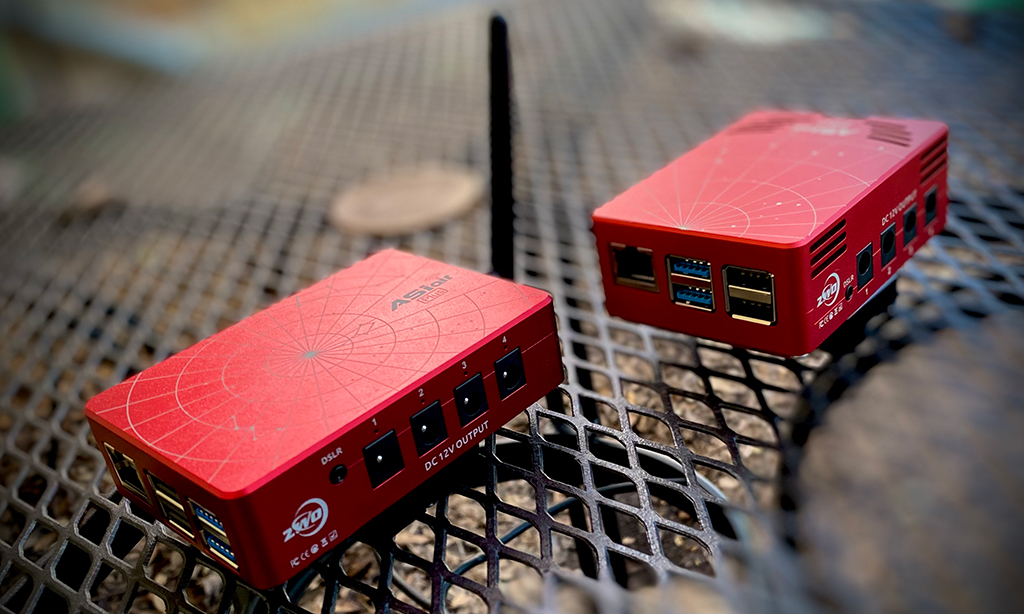
ASIAIR Plus (L) and Pro (R) side by side.
Background
I own a prior model ASIAIR Pro and use most of its functions except for electronic filter wheel and focusing. The Plus is based on very similar hardware to the Pro with some key improvements. The ASIAIR uses a phone or tablet app for user interface, different than alternatives which use remote desktop software. An app's more efficient use of wireless bandwidth allows a very responsive user interface with a very small footprint in size and power. This is great for users who travel and value a light, portable, kit.
Its functionality stops short of what you would want to control a permanent or remote observatory. With its built in 12V power control and USB hubs, it is a complete telescope and camera control solution about the size of a pack of cigarettes. Its amazingly low price does come with a tradeoff in flexibility. Support so far is limited to ZWO products and Nikon and Canon cameras (they are working on Sony).
I’ve found the ASIAIR’s app based software to be remarkably robust. It takes changes like loss of connection or switching networks in stride. The controller at your telescope keeps chugging along.The next time your device connects, the interface springs up exactly where you left it with the correct progress updated. With dark sky time at a premium, I value that my ASIAIR Pro has been one of the most reliable electronic devices that I own.
Most ASIAIR Pro users use a WiFi repeater. The RPi board uses an internal antenna for WiFi. The aluminum case that works so well for cooing reduces the range to just a few feet. The repeater isn't needed near the telescope. The biggest advantage of the Plus is that its external antenna lets you step inside and keep an eye on progress, without bring a repeater and its power supply.
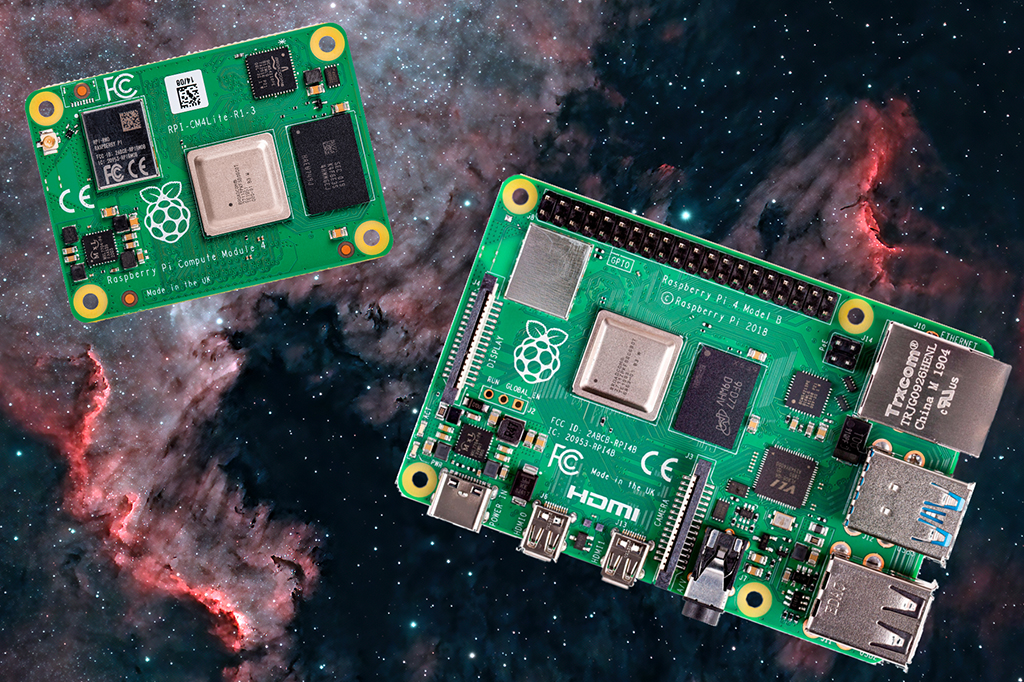
Raspberry Pi boards for Plus (RPi Compute Module on L) and Pro (RPi 4B on R)
ASIAIR Pro
The Pro is based on the Raspberry Pi (RPi) 4a complete single board ARM based computer. It adds a stylish red aluminum case that keeps the Pi cool without a fan. In addition to the standard RPi 4a board, ZWO has added a hat board with a 12V to 5V power supply for the Pi and a 12V power management hub. The Pro runs a custom locked down version of Linux, based on much familiar open source astronomy software. ZWO’s value added is integrating these components into a reliable work-flow that works flawlessly with their hardware.
The ASIAIR app based interface is responsive and robust. You can move from screen to screen without disturbing ongoing operations. Forget to set your camera cooler temperature? No problem just switch to the configuration screen and change the setting without disturbing the preview image acquisition. The software was written by people very familiar with the needs of astrophotographers.
ASIAIR Plus
In most ways the Plus is nearly identical to the Pro. The same app interface controls both from Apple and Android phones and tablets.
The Plus uses the Pi Compute Module 4. This includes the processor, RAM, eMMC storage (new), video processor, and WiFi radio with an external antenna connector. The RPi compute module 4 is smaller than the RPi 4a board used in the Pro. It now plugs into a larger board customized by ZWO. In addition to the 12V power supply and distribution hub it includes all of the I/O ports. A USB C port dedicated to an attached disk mode to offload images to PCs is added. Also included are the 2 USB3 and 2 USB2 ports of the Pro. The micro SD card slot is now used exclusively for image storage. The system disk with 20GB of image space has moved to high speed eMMC storage on the RPi compute module.
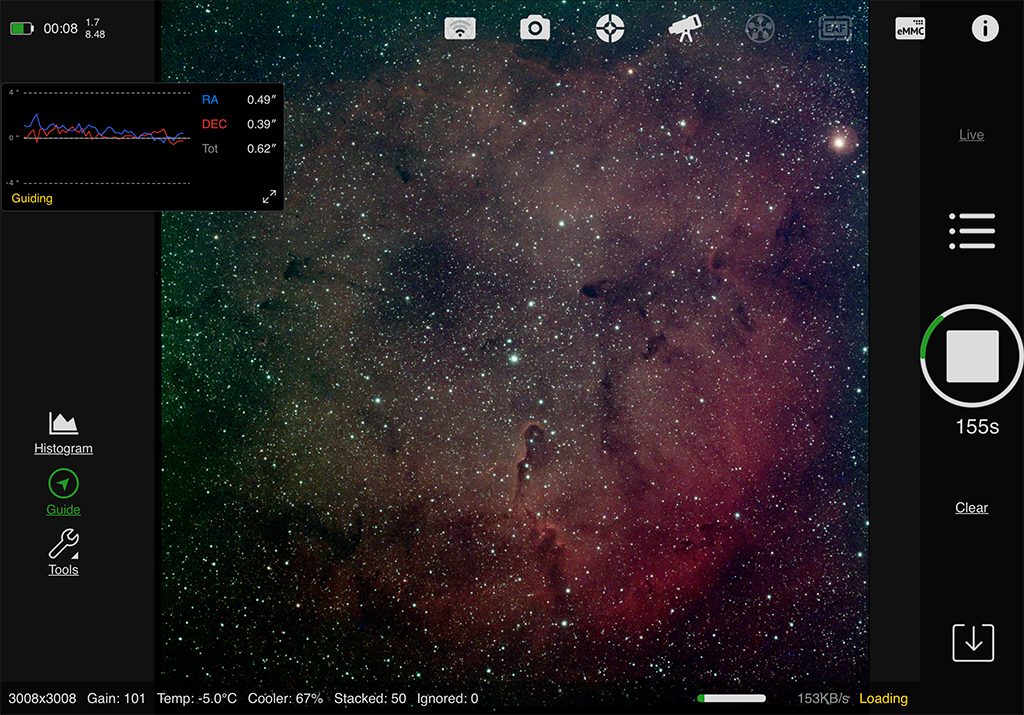
ASIAIR Plus or Pro? Both use the same app and user interface.
A closer look at the electronics
The Plus and the Pro use the same Broadcom BCM2711 quad-core Cortex-A72 (ARM v8) 64-bit SoC @ 1.5GHz processor, 4GB of RAM, GB Ethernet, and WiFi and Bluetooth radios. The eMMC system disk of the Plus is faster and more robust than the NAND flash micro SD card used in the Pro. On the Plus this frees the micro SD slot for up to 1 TB of removable image storage. The Plus’s USB C port allows high speed transfer of image data to a PC with the Plus booted; the app is not needed with the image store automatically mounting in your PC's file browser.
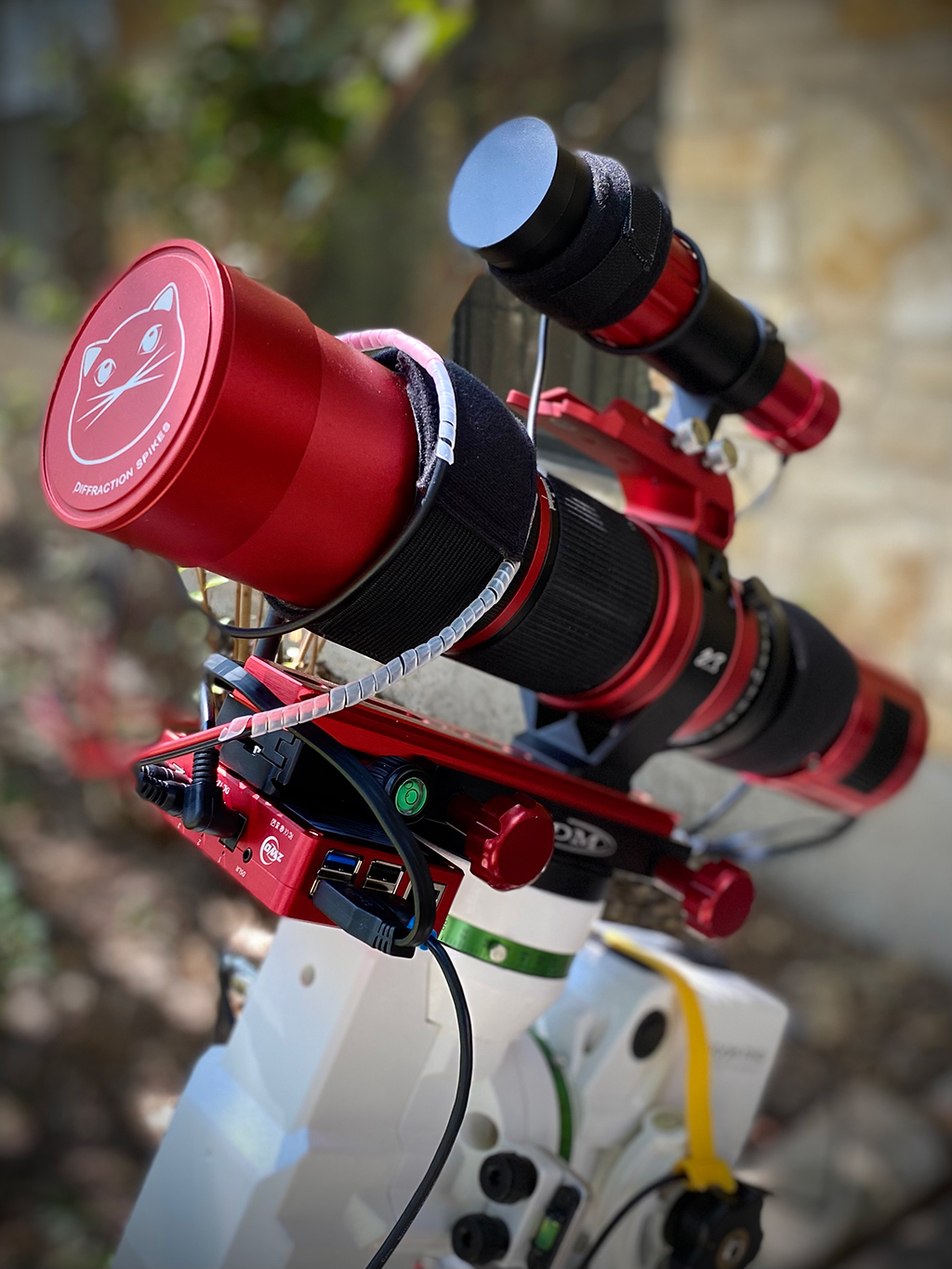
ASI Plus has red lights to show active 12v power ports. USB2 and USB3 ports are swapped.
Antenna and WiFi
The external antenna greatly increases WiFi range. I verified a useful 30m 2.4 GHz range. The Live View function requires much more bandwidth than the control and status functions. Effective use of Live View is restricted to less than half the maximum range.
I mount ASIAIR on the telescope dovetail to minimize the wires that could tangle. l found with the Pro that reception varies during a session as telescope motion changes the orientation of the fixed internal antenna. The external antenna of the Plus is moveable and it can be optimized for best reception.
I did find problems with the WiFi reliability on the version of the Plus that I was sent. In spite of the improved range I found that sometimes my tablet, even while very near by, would frequently disconnect and reconnect from the Plus. Once the Plus refused to reconnect via WiFi at all, until after I connected to it with an Ethernet wired connection from a hub. During 2 of my four long test sessions, I ended up swapping the Air for my Pro to complete my data acquisition because of WiFi issues. The other times it worked perfectly. When I had WiFi issues with the Plus, the Pro worked perfectly when substituted.
ZWO is working on this problem. Given the high reliability I experienced with the Pro and the similarity to the Plus, I expect this beta problem will be fixed shortly.

ASIAIR Plus needs space for dipole antenna adjustments.
The new case
At first glance the cases look almost identical. The Plus is slightly lighter, with a flatter aspect and slightly larger footprint. The lower height of the Plus increases clearance for those mounting it on their telescope rail. Although the Plus case doesn’t have the ventilation slots of the Pro, it runs as cool even in Texas heat.
The I/O ports, power switch, and 1/4x20 and M4 mounting holes are all located on the same sides of the case as with the Pro. This makes switching between a Pro and Plus easy. The position of the USB2 and USB3 ports is swapped; watch out for that if you swap.
A nice convenience is that each of the 12V power ports has a dim red LED status light next to it. A great reminder if you as forgetful as I am.
Memory and backups
ZWO claims that the new eMMC memory eliminates the need for system backups. The eMMC memory has a self healing feature. ZWO also saves a partition with a version of the OS which can be restored from an app menu item. It’s a factory version of the OS. It may be installed automatically or from an app menu.
This is easier for the user, eliminating copying the system disk image to a backup micro SD card. Personally, I liked the reassurance of having a backup memory card that I could exchange for a failed card at a moment’s notice. I’ve never had a failure with the Pro, but I’ve had SD cards fail in other devices. The Plus must boot and work well enough to initiate a recovery automatically or manually from the app in the new system. I’d feel more confident if ZWO provided a way for the user to recover a Plus system that won't boot via the micro SD slot or USB C port. The new scheme may be so reliable that this isn't needed; time will tell.
Moving the system disk to internal eMCC storage frees the micro SD slot for use as up to 1TB of dedicated image storage. NTFS, FAT32, or exFAT file systems are supported. This effectively frees one of the USB3 ports from a thumb drive for use with other peripheral.
Video frame rate
Video frame rate is important for planetary lucky imagers. Exposure time often limits the frame rate. Planets are bright and with a large aperture telescope, planetary video cameras can deliver frame rates of hundreds of frames per second. Video support is relatively new on the ASIAIR platform. While the Pro can deliver adequate frame rates, the 2 to 3 times faster eMMC memory hints that much better may be possible with the Plus.
Image storage speed is only one of the factors that will determine frame rate. To get a handle on the potential improvement, I tested frame rates with an ASI533 MC, averaged over 3 runs, for videos exposed at a short 100 microseconds, recorded to eMMC (managed NAND flash), USB3 NAND Flash thumb drive, and a fast SDXC class micro SD card.
| crop window | internal eMMC | 128GB SDXC micro SD | 64GB thumb drive |
|---|---|---|---|
| 320x240 | 206 | 143 | 206 |
| 480x360 | 135 | 85 | 132 |
| 640x480 | 87 | 56 | 56 |
| 1280x720 | 30 | 23 | 25 |
| 1920x1080 | 13 | 12 | 11 |
Results will vary with different cameras and removable media. My results were mixed. Measured improvement using the eMMC storage ranged from nothing to 55% for commonly used 640x480. These results are reasonable, but below frame rates with fast SSD storage on a fast laptop. Features are also limited, e.g. there is no crop frame location adjustment or object tracking and no atmospheric dispersion corrector support. The ASIAir Plus can meet the needs of casual planetary imagers without the need for a bulky laptop. ZWO has been aggressive in improving its software. I look forward to seeing this planetary video function improve.
Other improvements and future opportunities
Battery life is a worry for me imaging at dark sky locations. Switching to LiFeP04 batteries gives me more capacity in a small light package. However the LiFePO4 battery management system shuts down the batteries before my mount signals low voltage. I really appreciate the new voltage status information from the Plus app. I can keep an eye on how my batteries are holding up without having to go out in the cold.
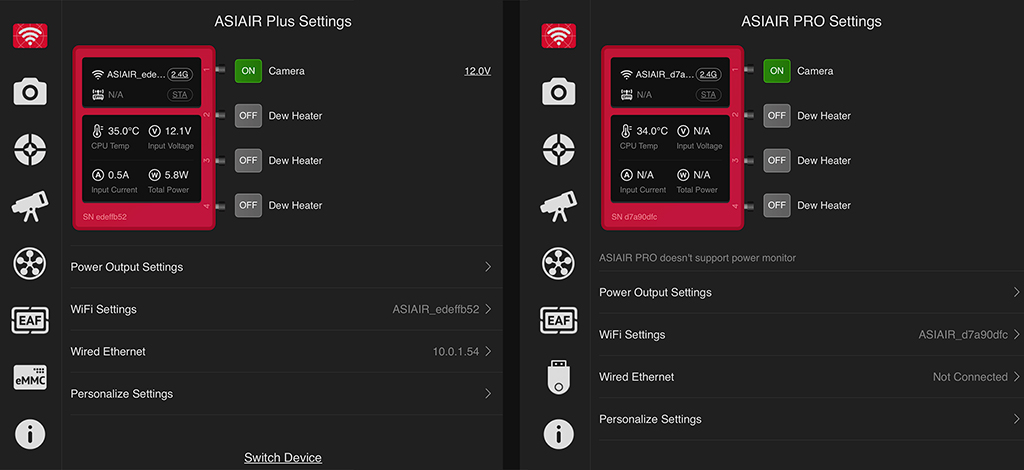
ASIAIR Plus covers battery users with in app voltage and power information display.
Now with the WiFi range extended in the Plus, another hardware weakness of the ASIAIR Pro is the power available for peripherals. The Pro meets the needs of most astrophotographers, but with little to spare. I've used up my four 12V power ports with my camera cooler and three dew heater strips. I could give up individual control of the dew strips and add a focuser and filter wheel, but more ports would be better. The 12V power distribution hub is limited to 3A per port, 6A total over the 4 ports. Most telescope mounts will require more than 3A and should not be powered through the hub.
The Raspberry Pi USB hub is limited to a total of 1.2 A of 5 V power, but the USB specification calls for as much as 2.8 A draw from two USB3 and two USB2 ports used all at the same time. While the USB spec is met for ports used individually, power can be inadequate for multiple USB devices. It appears that ZWO has stayed with the Raspberry Pi power limits in the Plus. Meeting the full spec for USB power on all ports in simultaneous use would allow reliable use of fast external USB3 hard drives, high power cameras, and future 5V peripherals like the ZWO EAF.
The Plus design puts both the USB and 12V power ports on a board that ZWO controls. I hoped to see boosted power capacity for peripherals in the Plus, but it appears that ZWO has stayed with the same specs as the Pro for these power ports.
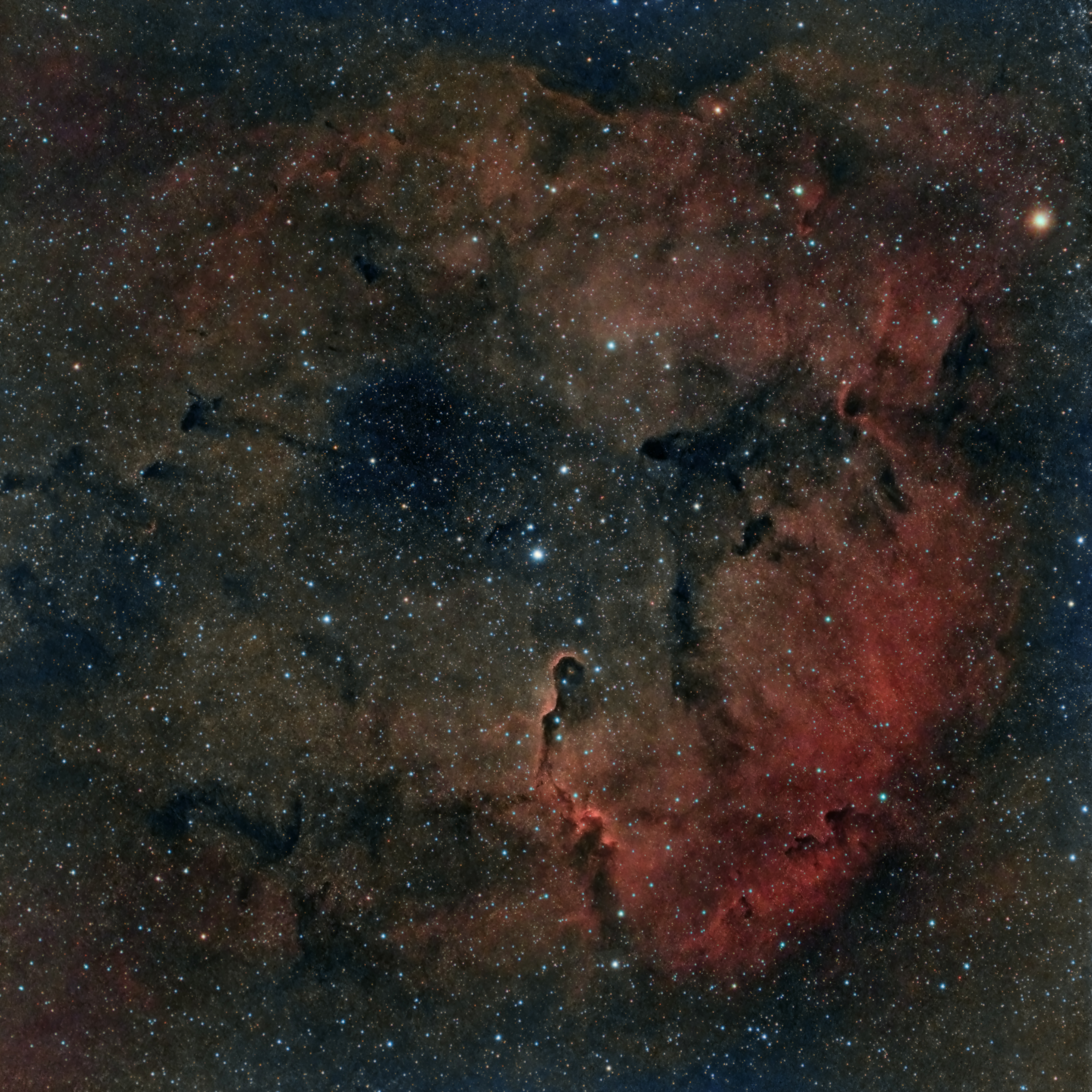
ASIAIR Plus Elephant Trunk 1st light, DSO astrophotographers get the same great results with the ASIAIR Plus as the Pro
Summary
What I like:
- Greater WiFi range with an external antenna
- Adjustable antenna for best reception
- Micro SD slot dedicated to image storage frees a USB port
- Modest improvement in video frame rates
- Added status lights on case and remote power monitoring in the app
What could be better:
- WiFi dropouts and lockups need to be fixed
- Increase 12V and 5V power port numbers and maximum power
- More supported cameras and peripherals outside ZWO products
- Manual filter wheel type for filter drawer users
- In app session notes saved with images to a text file or user supplied image meta-data
Should you upgrade to the ASIAIR Pro? Here is my personal take:
If you are using the original ASIAIR, this is a big upgrade well worth the cost.
If you are using an ASIAIR Pro now for imaging, you will not notice any change in your DSO images with the Plus. You may be able to get a higher frame rate in planetary videos depending on your crop size. Because the two products have the same CPU and memory, I don’t expect any updates to the Plus that will leave Pro users behind. If you are not happy with your WiFi range or if any of the other conveniences tickle your fancy, you will feel right at home moving to the Plus and its thoughtful redesign.
If you are using ZWO cameras (or want to) and don’t have an ASIAIR what are you waiting for? For about the price of an electronic polar scope, you can get an all in one astrophotography solution, with a great easy to use polar alignment.
For everyone else, ZWO has set a standard for functionality, ease of use, and price that is sure to inspire imitators.
I reviewed the ASIAIR Plus as part of the ASIAIR Experience Officer program. I received a discount on the purchase of this product in return for sharing my experiences with it.
Content created: 2021-09-29
Comments
![]() Submit comments or questions about this page.
Submit comments or questions about this page.
By submitting a comment, you agree that: it may be included here in whole or part, attributed to you, and its content is subject to the site wide Creative Commons licensing.

Blog
Silver City Heart & Soul Nebulae Revisited
Medulla or Garlic Nebula, CTB1, Abell 85
Nebulae afire off the belt of Orion
City Lights Horsehead & Flame Nebulae
Flaming Star Nebula dark sky vrs city sky face-off
Christmas Tree Cluster and Cone Nebula with more exposure
Christmas Tree Cluster with the Cone Nebula
Horsehead Nebula Face-Off Bortle 2 vrs Bortle 7
California Nebula Face-Off Bortle 2 vrs Bortle 7
Western Veil Nebula from Marfa
Trifid and Lagoon Nebulae Drizzle Stacked
North America and Penguin Nebulae Drizzle Stacked
Return to Coconino Andromeda, M31
Revisiting the Willow House Rosette
Corazón Incendida, the Heart Nebula
Elephant Trunk with the Garnet Star
Balanced HO North America & Pelican Nebulae
The Lagoon & Trifid Nebulas from Marfa
Western Veil Nebula from Marfa
The Great Winter Solstice Conjunction of Jupiter and Saturn
Two days to the Great Jupiter Saturn Conjunction
Worlds Apart, the Jupiter Saturn Conjunction
Raspberry Pi HQ camera first light
Waxing Crescent Moon with earthshine and stars
Vixen Porta II mount adapter or aluminum disk with holes #2
The 2019 ACEAP Expedition to Chile
Universe of Stories: Getting Started in Astronomy
View an Apollo flag on the Moon from Earth?
Apollo 50th is my 24th Flickr Explore Selection
Shooting the video stars - Moon and Jupiter
Ready for a change in perspective
Jupiter and the Galilean Moons through a camera lens
2022 the Solar System in one view
As hard to see as a doughnut on the Moon
Santa Inez miners church Terlingua
Waning gibbous Moon early Christmas Eve
Christmas eve on the eastern limb of the Moon
Mars at 23.3 arc sec with Syrtis Major
BadAstroPhotos Web Site Analytics
Saturn with Pixinsight workflow
Mars Update from Mauri Rosenthal
Waxing Gibbous Moon Terlingua Texas
Io Transit of Jupiter with the Great Red Spot
Not so bad Astro after 2 years
Eyes of the Llama from Urubamba
Moon and Venus over Cusco's El Monasterio
Tiangong-1 Space Station reentry tracking
Apollo - 50 years of human footprints on the Moon, complete!
Waxing Crescent Moon after Astrophotography Meetup
The Great American Eclipse from Above and Below
A million astro photo views on Flickr
Ansel Adams: Moonrise, Hernandez, New Mexico
December Solstice Crescent Moon with Earthshine
January 31 Blue Moon Lunar Eclipse
The Total Solar Eclipse in half a minute
2017 Solar Eclipse from a million miles away
Longhorn Eclipse from a Wyoming Hilltop
Fibs, damn lies, telescopes, and astrophotography
Full Moon before Total Solar Eclipse 2017
Longhorn Crescent Moon from Austin
The Crescent Moon with Jupiter and moons
Eye of the storm 2 - Juno & Jupiter's Great Red Spot
Eye of the storm - Juno & Jupiter's Great Red Spot
A million miles from earth, the Moon and earth east and west
Saturn with Titan, Dione, Tethys, & Rhea
Animated transit of Jupiter by Io
Solar Eclipse 2017 Highway Traffic Map
Mid-South Star Gaze + Questar Meet
Sweet Home Alabama Transit of Jupiter by Io
Update on AutoStakkert on macOS
Diffraction is not the limit for digital images
Teasing life into planetary images
Moon camera comparison: DSLR & planetary cameras
Waning Crescent Moon with Earthshine
1st day of Spring last quarter Moon
Lewis Morris Rutherfurd's Moon
Super Moonrise over Lady Bird Lake
360 Tower pierces the Super Moon
Lisbeth's Birthday Crescent Moon
The Moon and Mars from the Astro Café
Silent and Mechanical Shutter Comparison
Austin's Solar Sidewalk Sun-Day
Another Longhorn Moon over Austin
Jupiter and Venus do a father-daughter dance
Sunset with Mercury, Jupiter, and Venus
Mercury, Jupiter & Venus after sunset
3 months, 92 nations, 3750 visitors, 100,000+ images served
Upcoming Conjunction of Jupiter & Venus
The Perseid Meteor Shower with the Andromeda Galaxy
Waxing crescent Moon from UHD Video
NWS Interactive Digital Forecast Map
M7 the Ptolemy Cluster preview
Five Planets in the Sky at Dusk
Lucky Fat Waning Crescent Moon
Two months, 80 nations, and an embarrassing bug
Saturn with 5 moons: Titan, Rhea, Enceladus, Tethys, & Dione
The nearly full Moon and Saturn with a short tube refractor

 2025
2025
